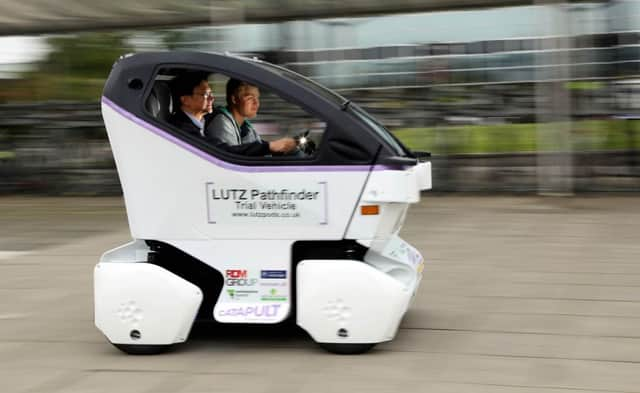Will motorists ever embrace the driverless vehicles?


An important trial of driverless vehicles has scooped the prestigious Automotive Award for Innovation from the Society of Motor Manufacturers and Traders. The trophy was in recognition of technology involved to bring three driverless pods to the streets of Milton Keynes to assess their viability and the response of the public.
Working in partnership with academics to develop the LUTZ Pathfinder (Low-carbon urban transport zone), the company behind the project is Transport Systems Catapult (TSC). It wants to show driverless pods can help drastically reduce road deaths and serious injuries by removing the human element from driving.
Advertisement
Hide AdAdvertisement
Hide AdTSC’s Steve Yianni said: “Ninety percent of collisions on the UK’s roads are due to human error in one way or another, so by allowing the vehicle to make decisions based on a broad array of information provided could help reduce this figure enormously.”
There is no dispute that most collisions are due to one or more driver making an error of judgement. Also, there are plenty of studies and statistics to prove that a driverless car future could make road deaths and serious injuries very rare and almost completely avoidable.
This is an admirable future to work towards. However, there are questions to be asked about the LUTZ Pathfinder project. For starters, the electrically powered pods will be driving in pedestrianised areas as well as on roads, yet they have a limited top speed of 15mph. This begs the question of how safe will they be mixing among other vehicles that may well be driving at considerably higher speeds?
To counter this to some extent, TSC says each of the three pods will be piloted by a trained driver to make sure there are no risks to passengers or pedestrians. This then raises another query about how useful is a driverless pod when it needs a driver present and can carry only a single passenger at a time, even if that passenger can be driven from door to door?
The plan is for the LUTZ Pathfinder pods to run until 2017, allowing plenty of time to collect and collate data from the trial. It’s certainly a sound way to reduce urban pollution and perhaps encourage some drivers to leave their car at home or at an out of town car park rather than drive into the town centre.
A problem arises, though, on another level. The pods use a 3D map of Milton Keynes coupled to on-board sensors to know where they are. While this means the pods are perfectly capable of conducting themselves safely, they will be in amongst other vehicles they cannot communicate with and that means they cannot predict or plan for their actions.
This is not a unique failing of the LUTZ Pathfinder, but a drawback of all driverless vehicles. Unless every vehicle on the road around them is using the same systems, there is a serious risk of one or more vehicles being unaware of the presence of other vehicles. The dangers here are obvious and just as potentially harmful as any vehicle driven by a human being.
The LUTX Pathfinder project should be applauded and it’s surely a step in the direction of driverless vehicles, but the reality of that future is a lot further away than the projects’ operators might hope.